Gabriele D’Annunzio the Abruzzese

Self-proclaimed “Superman” Gabriele D’Annunzio (Photo by New York Scugnizzo)
“In men of the highest character and noblest genius there is to be found an insatiable desire for honor, command, power and glory.”
– Cicero: De Oficiis, I, 78 B.C.
The end of World War I witnessed the breakup of three of the great royal dynasties of Europe. The Hohenzollern Empire of Germany, the Hapsburg Empire of Austria-Hungary and the Romanov Empire of Russia all went the way of the Imperium Romanum before them…into the misty and romanticized pages of history. In their places were created various new geopolitical entities ranging from ethno-states like Poland to multi-national states like Czechoslovakia. With some notable exceptions (like Yugoslavia) the new governments were republics.
Centuries of authoritarian, monarchial rule plus the exorbitant costs of the war left the new crop of leaders ill-equipped to deal with the problems afflicting their respective societies. Soon a wave of demagogues, strongmen and tinpot dictators would enter the picture, attempting to carve out a legacy for themselves in the ruins of postwar Europe.
In Hungary the Bolshevik revolutionary Béla Kun (née Cohn Béla) established a brutal, short-lived Communist regime (1919) before being overthrown in a disastrous war with Romania. He fled to the nascent Soviet Union where he lived, and continued to brutalize, until he was executed under Stalin’s orders in 1938 “…because he knew too much.” Kun’s brief reign was ironically instrumental in subsequently moving Hungarian politics far to the Right.
In one of the more laughable episodes of this period, on March 13th, 1920 a group of 5,000 Freikorps (German paramilitary volunteers) led by a man named Hermann Ehrhardt seized control of the city of Berlin, drove out the Weimar government, and installed a nondescript fellow by the name of Wolfgang Kapp as figurehead ‘Chancellor’. A group of rightists led by one General Walther von Luëttwitz was the real power behind the throne.
Kapp, a bespectacled bureaucrat and journalist, lacked the charisma to make a convincing frontman. Most of the other Freikorps and military commanders as well as conservative politicians refused to have anything to do with him or his “government”. Four days later the whole scheme fell apart when the Weimar Cabinet called for a general strike and Kapp fled to Sweden. The schlemiel died of cancer two years later while in German custody in Leipzig.
The only happening during the so-called “Kapp Putsch” worth noting was the effect a singular, harsh incident associated with it (the shooting of a rambunctious, small boy by several Freikorps troops) would have on an eyewitness: a young Austrian veteran of the German Army by the name of Adolf Hitler. Several years later in his book Mein Kampf he would remark it was his first lesson in the use of force to rule the masses.
While its monarchy survived the war, Italy was not immune to the intrigues of demagogues. One, in fact, would eventually seize power in 1922. Four years later he would proclaim himself dictator while keeping the King around as a figurehead. His name was Benito Mussolini. As Il Duce he would march Italy nearly to its ruin in World War II. Before all this happened, however, he would have to contend with another forceful personality who very nearly ‘stole his thunder’. Though Mussolini won the contest, he was nonetheless profoundly influenced by this most remarkable individual whose biography is studied to this day by those fascinated with the lives of “those who dare”.
Place of birth in Pescara
(Courtesy of Wikimedia Commons)

Gabriele D’Annunzio was born on March 12th, 1863 in the town of Pescara, Abruzzi. Just a couple of years earlier the region had been part of the Kingdom of the Two Sicilies before its conquest by Giuseppe Garibaldi. Some controversy apparently exists among historians as to D’Annunzio’s birth name. His father, Francesco Paolo Rapagnetta, had been adopted at the age of 13 by a childless uncle named Antonio D’Annunzio. He was raised with the surname Rapagnetta-D’Annunzio. In 1858 he married Luisa De Benedictis, by whom he had five children – three girls and two boys. According to Professor John Woodhouse (Fiat-Serena Prof. of Italian Studies, Univ. of Oxford), at the time of Gabriele’s baptism Rapagnetta had been dropped and the elder boy was officially registered as Gabriele D’Annunzio. Later in his life he would take to writing his surname as “d’Annunzio” to give it a more noble air.
Francesco Paolo had inherited half of his uncle’s fortune and as a result Gabriele and his siblings grew up fairly well off. His father, however, was a notorious drinker and womanizer who kept a string of mistresses. This caused no small amount of ill feeling between father and son. The level of dysfunctional feelings in the D’Annunzio family household was revealed when Gabriele refused to travel a short distance to be with his father before he died. After his father’s death, Gabriele realized the family had been saddled with heavy debts, forcing him to sell the D’Annunzio country home.
Gabriele D’Annunzio’s talents as a writer, as well as his disregard for personal danger, were recognized early in his life. An oft-repeated tale goes that a local fisherman had once given the boisterous lad a mussel to eat. In trying to pry it open he accidentally stabbed himself in the left thumb, bleeding profusely. Instead of running home to his mother for aid, he first ate the mollusk before binding the wound himself.
Originally tutored at home, at the age of 11 his father sent him to a prestigious boarding school, the Collegio Cicognini, in Prato, Tuscany. It must have made quite an impression on young Gabriele as years later he would describe this place as “…a plantation made in the images of the second Circle [of Dante’s Inferno], reducing the most vivacious of human saplings to ‘dried twigs with poison’. Oddly, he would later send both of his sons there when they were old enough.
D’Annunzio’s first brush with fame came in 1879 when he wrote and later published a small collection of 30 poems he entitled Primo vere. The poetry was written in the neo-Latin style of the great Tuscan poet (and future Nobel laureate) Giosuè Carducci. Against the rules of the Collegio Cicognini, he sent a complimentary copy of the book to Giuseppe Chiarini, one of Italy’s leading critics, who gave the book a mostly favorable review in the influential newspaper Il fanfulla della domenica.
Veiled bust of Eleonora Druse
(Photo by New York Scugnizzo)

It was also during his adolescent phase D’Annunzio discovered his fascination with, and his power over, women. He was known to have had at least several passionate affairs with females while still a teenager. Given his physique, this was certainly strange, for Gabriele D’Annunzio stood less than 5’6” tall, was slightly built, and had teeth that would make an Englishman envious! Yet despite this and the fact he would bald early in life, he was never lacking for female company.
In 1881 he entered l’Universita di Roma La Sapienza where he aggressively pursued a literary career by joining various literary groups and writing articles for a number of local newspapers. A year later he published his second volume of poetry, Canto novo, which illustrated his break with the austerity of Carducci’s style by its sensuality and exultation of nature. Some of the 63 poems in the book dealt with the poet’s love for the landscape of his native Abruzzi.
Shortly after this he published Terra Vergine (It: Virgin Land), a collection of short stories dealing with the hardships of peasant life in his native Abruzzi. It was inspired by the pen of noted Sicilian writer Giovanni Verga, who achieved fame by his tales of the grinding poverty in his own native Sicily. For this some accused D’Annunzio of copying Verga’s ideas and plots. Most, though, recognized the originality of D’Annunzio’s work, especially his penchant for the shocking and grotesque. This contrasted with Verga’s use of pathos to arouse sympathy in the reader. Their writings were similar only in the subject matter.
When circumstances forced him to temporarily ‘retire’ from his journalistic activities, he devoted himself to writing novels. His first, Il piacere (1889), was later translated into English as The Child of Pleasure. His next novel was Giovanni Episcopo (1891). It was his third novel, L’innocente (It: The Intruder), published in 1892 and later translated into French, that first brought him attention and acclaim from foreign critics. His pen worked feverishly after this, creating novels and books of poetry. Of the former, his novel Il fuoco (1900) is considered by many literary critics to be the most lavish glorification of any city (in this case, Venice) ever written. Of the latter, his book Il Poema Paradisiaco (1893) is considered among the finest examples of D’Annunzio’s poetry.
His entrance into upper-class Roman society came in the form of a young, attractive woman named Maria Hardouin di Gallese. He seduced and impregnated her in April of1893, marrying her four months later under a cloud of scandal. Maria was the daughter of a noble house, and her father, a duke, strongly disapproved of D’Annunzio as a son-in-law. He was even conspicuously absent from their wedding. Though initially smitten with his young bride, Gabriele would later develop the disinterest that characterized his relationships with women throughout his life. After bringing three sons into the world, D’Annunzio and his wife divorced in 1891.
It would seem only natural a man with his surpassing ambitions would develop an interest in politics, and in that regard Gabriele D’Annunzio would hardly defy convention. Taking advantage of a vacancy in the Italian Parliament, D’Annunzio campaigned for a seat representing Ortona a Mare in his native Abruzzi. It was at this time D’Annunzio the dramatist first made use of giving speeches from balconies to the masses, one of many innovations of his that his fascist protégé Benito Mussolini would later emulate.
By 1897 he was elected to the Chamber of Deputies where he sat for three years as an independent. His devil-may-care attitude, however, caused him to amass a sizable debt. He was eventually forced to flee Italy for France to escape his creditors. During his self-imposed exile he did not grow lax. Among his works he wrote the Italian libretto for Pietro Mascagni’s powerful but inordinately long opera Parasina. In 1908 he took a flight with aviation pioneer Wilbur Wright, which piqued D’Annunzio’s interest in flying. He proved to be an able aviator.

D'Annunzio's airplane navigator scroll (Photo by New York Scugnizzo)
World War I saw his return to Italy in the spring of 1915 where he campaigned extensively for that country’s entry into the war on the side of the Triple Entente (UK, France and Russia). Unbeknownst to him was the fact Italy had by April 26th, 1915 signed a treaty (known later as the Treaty of London) pledging to enter the war on the side of the entente powers. After Italy entered the war on May 23rd, 1915, he volunteered his services as a fighter pilot, taking part in many battles. The publicity he received fueled his already tremendous ego. On January 16th, 1916 while trying to fly over the city of Trieste, his flying boat was attacked by Austrian fighter aircraft. Forced to make an emergency landing, he sustained an injury to the right side of his head which left him permanently blind in his right eye.
In spite of this serious injury, he continued to fly missions into Austrian territory. In August of 1917 he led no less than three daring bombing raids on the Austrian port city of Pola (now Pula, Croatia). These raids became famous in part because of D’Annunzio’s insistence his Italian airmen celebrate the success of each raid by yelling out the ancient Greco-Roman battle cry of “Eia, eia, eia, alala!” instead of the more traditional Germanic “Ip, ip, urrah!” which he considered uncouth and barbaric.

D'Annunzio's model SVA (Photo by New York Scugnizzo)
On October 24th, 1917 Italy suffered its greatest defeat of the war in the disaster at Caporetto. On February 10-11th, 1918 he took part in a daring, if militarily unimportant raid, into Austrian territory now known as the Bakar Mockery. Though it achieved no physical military objective, it uplifted Italian morale which had suffered as a result of Caporetto while delivering a psychological blow to the Austrians.
D’Annunzio’s greatest feat during the war came on August 9th, 1918 when leading the 87th fighter squadron “La Serenissima” he dropped a total of 400,000 propaganda leaflets (50,000 of them painted in the colors of the Italian flag) over the city of Vienna, capital of the Austro-Hungarian Empire. This daring mission is immortalized in Italy as “Il Volo su Vienna” (It: The Flight over Vienna).
At war’s end the internationally acclaimed “fighter-poet” returned to Italy, his ultra-nationalist and irredentist feelings having been hardened by years of battle. With the collapse of the Hapsburg Empire of Austria-Hungary, he dreamed of Italy expanding into the Balkans by annexing lands historically inhabited by Italian-speaking peoples. It was a dream shared by many both in Italy and on the other side of the Adriatic Sea. What would follow would catapult Gabriele D’Annunzio to the pinnacle of the fame and controversy that characterized his life.
After the war Italian armies occupied considerable territory in the Trentino, South Tyrol, Venezia Giulia, the Istrian Peninsula, Dalmatia and most of what is now Albania. In fact, these were most of the lands promised them four years earlier by the entente powers.
What threw a monkey wrench in the works was a man named Woodrow Wilson, President of the United States. The U.S. had been a late entry into the war, and in the minds of American diplomats they didn’t have to abide by the terms of the Treaty of London. Since the administration of President Teddy Roosevelt, America’s WASP elites had turned their previous continent-specific belief in “Manifest Destiny” to a global arena. At the negotiations pursuant to the infamous Treaty of Versailles, Wilson let it be known he believed every recognizable ethnos had the right to self-determination (translation: America had vested business and political interests in the creation of the pseudo-nation known as Yugoslavia).
As documented by Prof. Woodhouse, Wilson also inherited that wonderful Anglo-American tradition known as anti-Italian bigotry. This tradition had revealed itself previously on numerous occasions, most notably on March 14th, 1891 when a total of 17 Sicilian-Americans were murdered by a lynch mob comprised of a good chunk of the adult male population of the city of New Orleans, Louisiana!
During the negotiations in Paris on April 23rd, 1919 the head of the American delegation went so far as to publish a column in the French newspaper Le Temps condemning what he called “Italian imperialism”. He arrogantly claimed Italian negotiators were acting “contrary to Italian public opinion” (without stating exactly how he knew this to be true).
The crux of all this was the city of Fiume (now Rijeka, Croatia). A number of powers (including America’s ‘good friend’ the UK) desired control of this strategically important area. Wilson was adamant Fiume be turned over to the nascent state of Yugoslavia to fulfill its right to ‘self-determination’. That the bulk of the citizenry was Italian-speaking and had already voted by a wide margin to become part of Italy was irrelevant.
D'Annunzio's Uniform
(Photo by New York Scugnizzo)

D’Annunzio the pan-Italian ultra-nationalist was furious with what he saw as American interference in what was basically an Italian affair. In a series of speeches he whipped up the Italian masses in preparation for his “grand adventure” in Fiume. His speeches denouncing the treachery of the Allies and the arrogance of Wilson were given wide coverage in the American press, which gratuitously heaped anti-Italian invectives on him in turn.
It also didn’t help the Italian government’s case that numerous private individuals besides D’Annunzio were taking matters into their own hands. Benito Mussolini by this time had organized his first bands of squadristi (the future Blackshirts) to battle his political opponents and pave the way for his eventual takeover of Italy. Giovanni Host-Venturi, a captain of the Arditi (elite Italian storm troopers during World War I) and a Major Giovanni Giuriati formed the Legione Fiumana (Fiume Legion) to take the port city by force, if necessary. American, British and French critics pointed to this as “proof” the Italians could not be depended upon to correctly administer the territories promised them.
On September 12th, 1919 at the head of a motley force of 2,500 irregulars, Gabriele D’Annunzio the “fighter-poet” invaded the city of Fiume. The inter-Allied force of British, American and French soldiers garrisoned there chose not to force a confrontation in order to avoid an international incident with their Italian allies. Instead they withdrew. From the governor’s balcony D’Annunzio addressed a throng of the citizenry and informed them of his plan to annex Fiume to Italy. Their wildly enthusiastic response affirmed in his mind the justness of his actions.
The Italian government, however, was not so enthusiastic. General Pietro Badoglio telegraphed the Italian soldiers who had followed D’Annunzio into Fiume that they were guilty of desertion. D’Annunzio reacted by publicly condemning the government for its weakness and indecision.
Similarly, he lashed out (though privately) at Mussolini, who up until this time was a partner in D’Annunzio’s endeavor. D’Annunzio had expected material support from Il Duce. Mussolini, however, was not yet strong enough to make such a move and chose to bide his time, instead. He even went so far as to edit and then publish the highly vituperative letter D’Annunzio had written, denouncing him, to make it seem the poet-hero was in fact supportive of him. Only in 1954 was the text of the original letter published. By then, though, D’Annunzio’s name had become so thoroughly linked with Fascism few were willing to stick their necks out to expose the true contempt he had early on developed for Mussolini and his movement.
Italian Prime Minister Francesco Saverio Nitti, realizing the weight of popular opinion was with D’Annunzio, offered him generous terms, among which was a general amnesty for him and his men. Fiume and surrounding territories would also be ultimately joined with Italy. All should have proceeded smoothly after this, but for the fact that it was now D’Annunzio himself who began to stonewall. A referendum by the people of Fiume seemed supportive of Nitti’s offer; D’Annunzio declared the vote null and void.
Apparently Gabriele D’Annunzio, like Gaius Julius Caesar 2,000 years before him, had become addicted to the powers he now wielded. The notoriety, and the legion of female admirers now at his disposal, didn’t hurt either. He rejected Nitti’s offer.
The government in Rome then demanded the plotters surrender and sent a naval task force to blockade Fiume. Things became embarrassing, however, when a number of Italian sailors, including basically the entire crew of the destroyer Espero, joined up with D’Annunzio’s forces. It has also been long alleged that a number of sympathetic rightists in Northern Italy’s industrial community clandestinely shipped supplies to D’Annunzio’s forces (in violation of the blockade) while claiming losses due to ‘piracy’.
Renato Brozzi Fiume medal
(Photo by New York Scugnizzo)

In retaliation for the blockade D’Annunzio declared Fiume an independent state, the Reggenza Italiana del Carnaro (It: Italian Regency of Carnaro) with himself as Duce. This was the closest he came to becoming the Renaissance despot he dreamed of being. As Duce he indulged his megalomania, giving balcony speeches, surrounding himself with military trappings, black-shirted followers and fostering a cult of personality.
With the help of Italian syndicalist Alceste De Ambris he wrote a constitution for Fiume, the Carta del Carnaro (It: Charter of Carnaro), which combined elements of syndicalist, corporatist and liberal republican ideals. The Charter stipulated that Fiume was a corporatist state, with nine corporations controlling various sectors of the economy and a tenth, created by D’Annunzio, representing the people he judged to be ‘superior’ (poets, prophets, heroes and “supermen”).
It must be mentioned D’Annunzio’s idea of the ‘superman’ was more in line with the philosophical vision of Nietzsche rather than the racial one of Hitler. It is also worth noting the Charter declared music to be the fundamental principle of the state. This document plus D’Annunzio’s antics in Fiume greatly interested Benito Mussolini and in no small way influenced the future course of Fascism in Italy. In fact, D’Annunzio has been described by his detractors as the “John the Baptist of Fascism”.
On November 12, 1920 Italy signed the Treaty of Rapallo with the newly-formed Kingdom of Serbs, Croats and Slovenes (renamed Yugoslavia in 1929) which, among other things, established Fiume as the independent “Free State of Fiume”, effectively ending D’Annunzio’s dictatorship. D’Annunzio responded by declaring war on Italy. By this time it was obvious his hold on the city was crumbling. On Christmas Eve Italian troops invaded Fiume in the face of stiff resistance from diehard loyalists. A naval artillery shell from the Andrea Doria through the window of his headquarters impressed upon him the wisdom of surrender.
In a way, though, he won. Fiume would be a de facto Italian possession by 1924. It would remain so until the end of World War II when the victorious Allies would pry it from Italian hands and give it to Yugoslavia (after the ‘ethnic cleansing’ of its Italian population).
Far from returning with his tail between his legs, D’Annunzio’s popularity with the Italian populace was actually enhanced by his Fiume adventure. In spite of claims by many of his Fascist sympathies, he consistently refused to have anything to do with the movement. He even ignored fascist entreaties to run in the elections on May 21, 1921.

Piazza G. D'Annunzio, Ravenna (Photo by New York Scugnizzo)
In spite of this, Mussolini regarded the erstwhile dictator as a rival for his future control of Italy. His fears were probably well-placed as by this time a number of high-ranking members of the Fascist Party of Italy, including Blackshirt leader Italo Balbo, seriously considered the idea of turning to D’Annunzio for leadership. Thus, on August 13th, 1922, when Gabriele D’Annunzio fell out of a window two days before a scheduled meeting with Mussolini and Italian PM Nitti, many believed (and still believe) he had ‘help’ from some of Il Duce’s thugs.
D’Annunzio’s injuries as a result of his fall incapacitated him, leaving him unable to witness Mussolini’s triumphal “March on Rome” (October 22-29, 1922). After this he withdrew from politics, though he still from time to time “stuck his two cents in” many of Mussolini’s decisions. In 1924, after Italy formally annexed Fiume, D’Annunzio was ennobled the Prince of Monte Nevoso by the King upon the ‘recommendation’ of Mussolini. He approved of the Italian invasion of Ethiopia in 1935. However, he was adamantly opposed (along with Italo Balbo) to Mussolini having anything to do with Adolf Hitler, whom he contemptuously referred to in a letter to Mussolini as a marrano (Sp: swine).
Mussolini, for his part, was content to leave D’Annunzio alone after his ascension to power, preferring instead to regularly dole out large sums of money to him to finance his various egocentric projects. The most notable of these was a museum to himself D’Annunzio began during his lifetime, dubbed Il Vittoriale degli Italiani (It: The Shrine of Italian Victories) and located at his estate in Gardone Riviera, Lombardia. It contains his mausoleum.
Gabriele D’Annunzio died on March 1st, 1938, presumably of a stroke. His death caused a period of national mourning throughout Italy and beyond. Even in countries now hostile to Italy his passing was noted with sorrow. No less than The Times of London published this eulogy of him under the heading “The Spirit of the Cinquecento”:
Poet, novelist and politician, dramatist and demagogue, aesthete and soldier, Gabriele D’Annunzio, Prince of Monte Nevoso, is dead. No poet of our time has led a fuller life than this Byron of the modern world […] showed himself a fighter of dauntless courage and a politician who swayed the fortunes of Europe […] bore his wounds with stoic fortitude.
After his death his memory would be all but buried with him for the next 50 years. Scholars in recent decades, however, have shown a renewed interest in his life and works.
It would be simple to dismiss him as a mere hedonist and fascist (as many have done), ignoring his many contributions to the fields of journalism, poetry and drama. In truth, he was no fascist at all, for Gabriele D’Annunzio served neither Mussolini nor Fascism. He served no one and nothing other than his own ego and surpassing ambitions. His inability to form a lasting relationship with women, plus his penchant for decadent living, were perhaps his greatest personal flaws, but history has a habit of forgiving earth-shakers their frailties. His love of nature and aesthetics, as well as his utter rejection of Hitler, put him on a much higher plane than the plebe who became ruler of Italy. Had he lived in an earlier time, today he might be numbered with other tragic heroes who tried and failed like Cola di Rienzo or even Pompey the Great. His legacy is most certainly clouded by the politics of our times. His biography remains a case study of one of the most fascinating and striking personalities of the early part of the 20th century.
Niccolò Graffio
Further reading:
• John Woodhouse: Gabriele D’Annunzio: Defiant Archangel, Clarendon Press, 1998
• http://www.gabrieledannunzio.net/english/index.htm
 Selon une idée fausse mais très répandue, les pamphlets – que feu Maurice Bardèche nommait satires – ne sont pas réédités en raison d'une interdiction officielle. En réalité, c'est Céline lui-même qui n'a pas souhaité cette réédition après la guerre. Sa veuve, Lucette Destouches, a maintenu cette censure durant un demi-siècle. Pas de manière totale puisqu'elle a autorisé la réédition de la préface de L'Ecole des cadavres (1942) dans un volume comprenant notamment les lettres adressées aux journaux de l'occupation (1). Sur son site internet (2), Henri Thyssens se demande si les pamphlets sont, en réalité, toujours interdits de publication par la République. Car ils le furent le 15 janvier 1945 : l'Office professionnel du Livre, émanation de ce qui s'appelait alors le ministère de la Guerre, adressa ce jour aux libraires une première liste d'ouvrages à retirer de la vente (3). On y trouve une demi-douzaine de titres des éditions Denoël dont les trois pamphlets de Céline : Bagatelles pour un massacre, L'École des cadavres et Les Beaux draps. Autres maisons frappées par cette mesure d'interdiction : les éditions Balzac (ex-Calmann Lévy), Debresse, Baudinière, Grasset et Sorlot. Mais pas Gallimard curieusement. Or en juillet 1945 le Contrôle militaire précisera que ces listes étaient établies en vue de retirer de la circulation non seulement des oeuvres d'esprit collaborationniste, mais aussi des livres s'inspirant des principes de la Révolution nationale. Par ailleurs, ces mesures d'épuration frappaient les ouvrages en particulier et non les auteurs en général. Le statut de ces listes d'interdiction reste à définir. Mais le point décisif est de savoir si cette directive a été abrogée. Henri Thyssens pense que ça n'a pas été le cas.
Selon une idée fausse mais très répandue, les pamphlets – que feu Maurice Bardèche nommait satires – ne sont pas réédités en raison d'une interdiction officielle. En réalité, c'est Céline lui-même qui n'a pas souhaité cette réédition après la guerre. Sa veuve, Lucette Destouches, a maintenu cette censure durant un demi-siècle. Pas de manière totale puisqu'elle a autorisé la réédition de la préface de L'Ecole des cadavres (1942) dans un volume comprenant notamment les lettres adressées aux journaux de l'occupation (1). Sur son site internet (2), Henri Thyssens se demande si les pamphlets sont, en réalité, toujours interdits de publication par la République. Car ils le furent le 15 janvier 1945 : l'Office professionnel du Livre, émanation de ce qui s'appelait alors le ministère de la Guerre, adressa ce jour aux libraires une première liste d'ouvrages à retirer de la vente (3). On y trouve une demi-douzaine de titres des éditions Denoël dont les trois pamphlets de Céline : Bagatelles pour un massacre, L'École des cadavres et Les Beaux draps. Autres maisons frappées par cette mesure d'interdiction : les éditions Balzac (ex-Calmann Lévy), Debresse, Baudinière, Grasset et Sorlot. Mais pas Gallimard curieusement. Or en juillet 1945 le Contrôle militaire précisera que ces listes étaient établies en vue de retirer de la circulation non seulement des oeuvres d'esprit collaborationniste, mais aussi des livres s'inspirant des principes de la Révolution nationale. Par ailleurs, ces mesures d'épuration frappaient les ouvrages en particulier et non les auteurs en général. Le statut de ces listes d'interdiction reste à définir. Mais le point décisif est de savoir si cette directive a été abrogée. Henri Thyssens pense que ça n'a pas été le cas.



 Ses envolées guerrières, ses insultes faciles et ses outrances, cette exaltation que l’âge ne semblait pas devoir tempérer, tout cela s’étalait au fil de milliers de pages, entre deux hommages à Kelly Minogue ou Bertrand Burgalat. Ses T.D.O. sautaient du coq à l’âne, sans queue ni tête, sans début ni fin, bref, ils ressemblaient beaucoup trop à la vie pour qu’on puisse en tirer quelque chose d’aussi simple qu’un résumé.
Ses envolées guerrières, ses insultes faciles et ses outrances, cette exaltation que l’âge ne semblait pas devoir tempérer, tout cela s’étalait au fil de milliers de pages, entre deux hommages à Kelly Minogue ou Bertrand Burgalat. Ses T.D.O. sautaient du coq à l’âne, sans queue ni tête, sans début ni fin, bref, ils ressemblaient beaucoup trop à la vie pour qu’on puisse en tirer quelque chose d’aussi simple qu’un résumé. La joie qu’on pouvait sentir chez Maurice Dantec quant à la perspective de la mort prochaine de Saddam Hussein était d’ailleurs obscène. Saddam, qui avait sûrement plus fait pour combattre le fondamentalisme que n’importe qui d’autre. Saddam, qui avait été le seul, après le retrait d’Israël, à envoyer des armes aux chrétiens du Liban à la fin des années quatre-vingt. Saddam, qui avait embauché le chrétien Tareq Aziz comme vice-premier ministre, et donné à un de ses fils un prénom païen de l’ancienne Mésopotamie. Ce Saddam qui, aux yeux de Dantec, ressemblait sûrement trop au méchant idéal dans un film de Chuck Norris. Sa chute fut, hélas, le signal, pour les islamistes, de l’ouverture de la chasse au Chaldéen.
La joie qu’on pouvait sentir chez Maurice Dantec quant à la perspective de la mort prochaine de Saddam Hussein était d’ailleurs obscène. Saddam, qui avait sûrement plus fait pour combattre le fondamentalisme que n’importe qui d’autre. Saddam, qui avait été le seul, après le retrait d’Israël, à envoyer des armes aux chrétiens du Liban à la fin des années quatre-vingt. Saddam, qui avait embauché le chrétien Tareq Aziz comme vice-premier ministre, et donné à un de ses fils un prénom païen de l’ancienne Mésopotamie. Ce Saddam qui, aux yeux de Dantec, ressemblait sûrement trop au méchant idéal dans un film de Chuck Norris. Sa chute fut, hélas, le signal, pour les islamistes, de l’ouverture de la chasse au Chaldéen.
 del.icio.us
del.icio.us
 Digg
Digg Vi sono scelte che non vengono perdonate, che fruttano al proprio autore la «damnatio memoriae» perpetua, indipendentemente dal valore del personaggio e da tutto quanto egli possa aver detto o fatto di notevole, prima di compiere, magari per ragioni contingenti e sostanzialmente in buona fede, quella tale scelta infelice.
Vi sono scelte che non vengono perdonate, che fruttano al proprio autore la «damnatio memoriae» perpetua, indipendentemente dal valore del personaggio e da tutto quanto egli possa aver detto o fatto di notevole, prima di compiere, magari per ragioni contingenti e sostanzialmente in buona fede, quella tale scelta infelice.

 Nella sua ricerca di un nuovo ordine europeo che consentisse alle «patrie» francese, tedesca, inglese, italiana, di continuare a svolgere un ruolo mondiale nell’era dei colossi imperiali, si era accostato anche a certi ambienti industriali e finanziari che egli definiva «capitalismo intelligente», perché aveva intuito che, in un mondo globalizzato, anche il capitalismo avrebbe potuto svolgere una funzione utile, purché si dissociasse dal nazionalismo e contribuisse a creare migliori condizioni di vita per gli abitanti del Vecchio Continente. Grande utopista, e forse sognatore, Drieu La Rochelle si rendeva però conto della importanza dei fattori materiali della vita moderna, e intendeva inserirli nel quadro della nuova Europa da costruire.
Nella sua ricerca di un nuovo ordine europeo che consentisse alle «patrie» francese, tedesca, inglese, italiana, di continuare a svolgere un ruolo mondiale nell’era dei colossi imperiali, si era accostato anche a certi ambienti industriali e finanziari che egli definiva «capitalismo intelligente», perché aveva intuito che, in un mondo globalizzato, anche il capitalismo avrebbe potuto svolgere una funzione utile, purché si dissociasse dal nazionalismo e contribuisse a creare migliori condizioni di vita per gli abitanti del Vecchio Continente. Grande utopista, e forse sognatore, Drieu La Rochelle si rendeva però conto della importanza dei fattori materiali della vita moderna, e intendeva inserirli nel quadro della nuova Europa da costruire.



 L’educazione non aveva altro scopo che l’esaltazione del coraggio e della energia. I ragazzi vivevano tra loro il più presto possibile, in truppe analoghe a quelle dei balilla dell’Italia fascista o della Hitlerjugend, di cui facevano parte dalla età di sette anni. […]
L’educazione non aveva altro scopo che l’esaltazione del coraggio e della energia. I ragazzi vivevano tra loro il più presto possibile, in truppe analoghe a quelle dei balilla dell’Italia fascista o della Hitlerjugend, di cui facevano parte dalla età di sette anni. […]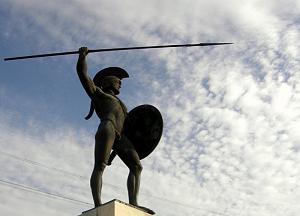 A noi che siamo cresciti nella apparente ovvietà del sistema democratico, sfugge come l’umanità abbia potuto governarsi per millenni senza di esso, pur realizzando opere egregie; e sfugge come il cosiddetto miracolo greco non consista solo nella democrazia ateniese, ma anche nella oligarchia spartana, fondata su un valore che non è quantificabile in termini economici, ma solo e unicamente in termini di onore, dovere e spirito di sacrificio.
A noi che siamo cresciti nella apparente ovvietà del sistema democratico, sfugge come l’umanità abbia potuto governarsi per millenni senza di esso, pur realizzando opere egregie; e sfugge come il cosiddetto miracolo greco non consista solo nella democrazia ateniese, ma anche nella oligarchia spartana, fondata su un valore che non è quantificabile in termini economici, ma solo e unicamente in termini di onore, dovere e spirito di sacrificio.





 TODAY MARKS the 200th anniversary of the birth of the European-American literary genius and racially concious writer Edgar Allan Poe. I have paid my respects to the eternal memory of Edgar Poe in person at the Poe Museum in Richmond and at his and his beloved Virginia’s grave site in Baltimore, and I offer them again to all who read my words today.
TODAY MARKS the 200th anniversary of the birth of the European-American literary genius and racially concious writer Edgar Allan Poe. I have paid my respects to the eternal memory of Edgar Poe in person at the Poe Museum in Richmond and at his and his beloved Virginia’s grave site in Baltimore, and I offer them again to all who read my words today.
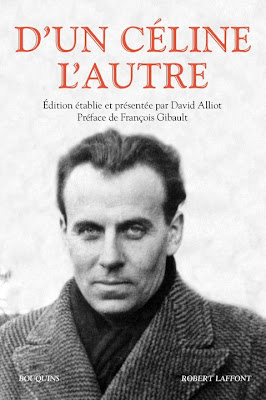









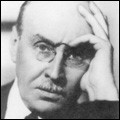 Or le contexte a rapidement changé après le Traité de Versailles, dont la Belgique sort largement dupée par les quatre grandes puissances (Etats-Unis, France, Grande-Bretagne, Italie), comme l’écrivait clairement Henri Davignon (photo ci-contre), dans son ouvrage « La première tourmente », consacré à ses activités diplomatiques en Angleterre pendant la première guerre mondiale. Après Versailles, nous avons Locarno (1925), qui éveille les espoirs d’une réconciliation généralisée en Europe. Ensuite, les accords militaires franco-belges sont de plus en plus contestés par les socialistes et les forces du mouvement flamand, puis, dans un deuxième temps, par le Roi et son état-major (qui critiquent l’immobilisme de la stratégie française marquée par Maginot) et, enfin, par les catholiques inquiets de la progression politique des gauches françaises. Tout cela suscite le désir de se redonner une originalité intellectuelle et littéraire marquée de « belgicismes », donc de « vernacularités » wallonne et flamande. L’univers littéraire de la droite catholique francophone va donc simultanément s’ouvrir, dès la fin des années 20, à la Flandre en tant que Flandre flamande et à la Wallonie dans toutes ses dimensions vernaculaires.
Or le contexte a rapidement changé après le Traité de Versailles, dont la Belgique sort largement dupée par les quatre grandes puissances (Etats-Unis, France, Grande-Bretagne, Italie), comme l’écrivait clairement Henri Davignon (photo ci-contre), dans son ouvrage « La première tourmente », consacré à ses activités diplomatiques en Angleterre pendant la première guerre mondiale. Après Versailles, nous avons Locarno (1925), qui éveille les espoirs d’une réconciliation généralisée en Europe. Ensuite, les accords militaires franco-belges sont de plus en plus contestés par les socialistes et les forces du mouvement flamand, puis, dans un deuxième temps, par le Roi et son état-major (qui critiquent l’immobilisme de la stratégie française marquée par Maginot) et, enfin, par les catholiques inquiets de la progression politique des gauches françaises. Tout cela suscite le désir de se redonner une originalité intellectuelle et littéraire marquée de « belgicismes », donc de « vernacularités » wallonne et flamande. L’univers littéraire de la droite catholique francophone va donc simultanément s’ouvrir, dès la fin des années 20, à la Flandre en tant que Flandre flamande et à la Wallonie dans toutes ses dimensions vernaculaires.  L’aristocrate gantois Roger Kervyn de Marcke ten Driessche (né en 1896 - photo ci-contre) franchit un pas de plus dans ce glissement vers la reconnaissance de la diversité littéraire belge, issue de la diversité dialectale et linguistique du pays. Kervyn se veut « passeur » : l’élite belge, et donc son aristocratie, doit viser le bilinguisme parfait pour conserver son rôle dans la société à venir, souligne Cécile Vanderpelen-Diagre. Kervyn assume dès lors le rôle de « passeur » donc de traducteur ; il passera toutes les années 30 à traduire articles, essais et livres flamands pour la « Revue Belge » et pour les Editions Rex. On finit par considérer, dans la foulée de cette action individuelle d’un Gantois francophone, que le « monolinguisme est trahison ». Le terme est fort, bien sûr, mais, même si l’on fait abstraction du cadre étatique belge, avec ses institutions à l’époque très centralisées (le fédéralisme ne sera réalisé définitivement qu’au début des années 90 du 20ème siècle), peut-on saisir les dynamiques à l’œuvre dans l’espace entre Somme et Rhin, peut-on sonder les mentalités, en ne maniant qu’une et une seule panoplie d’outils linguistiques ? Non, bien évidemment. Néerlandais, français et allemand, avec toutes leurs variantes dialectales, s’avèrent nécessaires. Pour Cécile Vanderpelen-Diagre, le bel ouvrage de Charles d’Ydewalle, « Enfances en Flandre » (1935) ne décrit que les sentiments et les mœurs des francophones de Flandre, essentiellement de Bruges et de Gand. A ce titre, il ne participe pas du mouvement que Kervyn a voulu impulser. C’est exact. Et les humbles du menu peuple sont les grands absents du livre de d’Ydewalle, de même que les représentants de l’élite alternative qui se dressait dans les collèges catholiques et dans les cures rurales (Cyriel Verschaeve !). Il n’empêche qu’une bonne lecture d’ « Enfances en Flandre » de d’Ydewalle permettrait à des auteurs flamands, et surtout à des créateurs cinématographiques, de mieux camper bourgeois et francophones de Flandre dans leurs oeuvres. Ensuite, les notes de d’Ydewalle sur le passé de la terre flamande de César aux « Communiers », et sur le dialecte ouest-flamand qu’il défend avec chaleur, méritent amplement le détour.
L’aristocrate gantois Roger Kervyn de Marcke ten Driessche (né en 1896 - photo ci-contre) franchit un pas de plus dans ce glissement vers la reconnaissance de la diversité littéraire belge, issue de la diversité dialectale et linguistique du pays. Kervyn se veut « passeur » : l’élite belge, et donc son aristocratie, doit viser le bilinguisme parfait pour conserver son rôle dans la société à venir, souligne Cécile Vanderpelen-Diagre. Kervyn assume dès lors le rôle de « passeur » donc de traducteur ; il passera toutes les années 30 à traduire articles, essais et livres flamands pour la « Revue Belge » et pour les Editions Rex. On finit par considérer, dans la foulée de cette action individuelle d’un Gantois francophone, que le « monolinguisme est trahison ». Le terme est fort, bien sûr, mais, même si l’on fait abstraction du cadre étatique belge, avec ses institutions à l’époque très centralisées (le fédéralisme ne sera réalisé définitivement qu’au début des années 90 du 20ème siècle), peut-on saisir les dynamiques à l’œuvre dans l’espace entre Somme et Rhin, peut-on sonder les mentalités, en ne maniant qu’une et une seule panoplie d’outils linguistiques ? Non, bien évidemment. Néerlandais, français et allemand, avec toutes leurs variantes dialectales, s’avèrent nécessaires. Pour Cécile Vanderpelen-Diagre, le bel ouvrage de Charles d’Ydewalle, « Enfances en Flandre » (1935) ne décrit que les sentiments et les mœurs des francophones de Flandre, essentiellement de Bruges et de Gand. A ce titre, il ne participe pas du mouvement que Kervyn a voulu impulser. C’est exact. Et les humbles du menu peuple sont les grands absents du livre de d’Ydewalle, de même que les représentants de l’élite alternative qui se dressait dans les collèges catholiques et dans les cures rurales (Cyriel Verschaeve !). Il n’empêche qu’une bonne lecture d’ « Enfances en Flandre » de d’Ydewalle permettrait à des auteurs flamands, et surtout à des créateurs cinématographiques, de mieux camper bourgeois et francophones de Flandre dans leurs oeuvres. Ensuite, les notes de d’Ydewalle sur le passé de la terre flamande de César aux « Communiers », et sur le dialecte ouest-flamand qu’il défend avec chaleur, méritent amplement le détour.
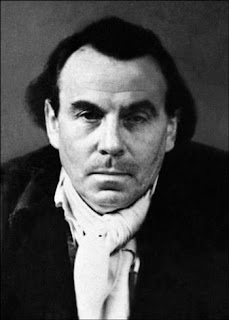


 Se non ora quando? La donna e la sua dignità, il suo ruolo sociale. La posizione da assumere all’interno e nei confronti del sistema Italia. Dibattiti su dibattiti, manifestazioni, mobilitazioni in nome di una rinascita in gonnella, appelli infuocati al popolo rosa. Costruzione di una nuova identità femminile o starnazzo di gallinelle? La donna paragonata all’uomo, divisione fra sessi al centro di battaglie e rivendicazioni che sanciscono nuove superiorità o inferiorità?
Se non ora quando? La donna e la sua dignità, il suo ruolo sociale. La posizione da assumere all’interno e nei confronti del sistema Italia. Dibattiti su dibattiti, manifestazioni, mobilitazioni in nome di una rinascita in gonnella, appelli infuocati al popolo rosa. Costruzione di una nuova identità femminile o starnazzo di gallinelle? La donna paragonata all’uomo, divisione fra sessi al centro di battaglie e rivendicazioni che sanciscono nuove superiorità o inferiorità?
 Louis-Ferdinand Céline (1894–1961) is my favorite writer I don’t enjoy reading, much as Vertigo is my favorite movie I don’t enjoy watching.
Louis-Ferdinand Céline (1894–1961) is my favorite writer I don’t enjoy reading, much as Vertigo is my favorite movie I don’t enjoy watching.
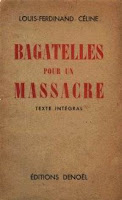
 Voor zijn succes als militair schrijver, was er eerst Mabire de Alpenverkenner (De chasseurs alpins waren een verkennerseenheid van de toenmalige franse infanterie) , die al op dertigjarige leeftijd als reserve-luitenant werd opgeroepen om onder de nationale vlag zijn diensttijd uit te dienen in het Algerijnse bergland (Djebel). Een wapenonderdeel als geen ander, dat Mabire zijn hele leven trouw zou blijven. Echter niets bestemde de Normandische schrijver voor, zich te tooien met de bekende koningsblauwe ‘taart’ het hoofddeksel der verkenners.
Voor zijn succes als militair schrijver, was er eerst Mabire de Alpenverkenner (De chasseurs alpins waren een verkennerseenheid van de toenmalige franse infanterie) , die al op dertigjarige leeftijd als reserve-luitenant werd opgeroepen om onder de nationale vlag zijn diensttijd uit te dienen in het Algerijnse bergland (Djebel). Een wapenonderdeel als geen ander, dat Mabire zijn hele leven trouw zou blijven. Echter niets bestemde de Normandische schrijver voor, zich te tooien met de bekende koningsblauwe ‘taart’ het hoofddeksel der verkenners. 
 L’anno in cui si incontrarono, il 1928, Victoria Ocampo era una bella e ricca argentina non ancora quarantenne, sposata, ma di fatto separata e con un unico grande amore alle spalle, e Pierre Drieu La Rochelle un brillante trentacinquenne senza lavoro fisso, al secondo e già fallito matrimonio, con molte avventure sentimentali dietro di lui. Che cosa spingesse l’una nelle braccia dell’altro e viceversa non è facile dire: negli scrittori Victoria cercava gli uomini, anche se pur sempre come intesa di anime, più che di corpi; quanto a Drieu, la sua attrazione era figlia della prevenzione, il fascino esercitato da una donna intelligente, ovvero ai suoi occhi un controsenso, se non un elemento contro natura.
L’anno in cui si incontrarono, il 1928, Victoria Ocampo era una bella e ricca argentina non ancora quarantenne, sposata, ma di fatto separata e con un unico grande amore alle spalle, e Pierre Drieu La Rochelle un brillante trentacinquenne senza lavoro fisso, al secondo e già fallito matrimonio, con molte avventure sentimentali dietro di lui. Che cosa spingesse l’una nelle braccia dell’altro e viceversa non è facile dire: negli scrittori Victoria cercava gli uomini, anche se pur sempre come intesa di anime, più che di corpi; quanto a Drieu, la sua attrazione era figlia della prevenzione, il fascino esercitato da una donna intelligente, ovvero ai suoi occhi un controsenso, se non un elemento contro natura.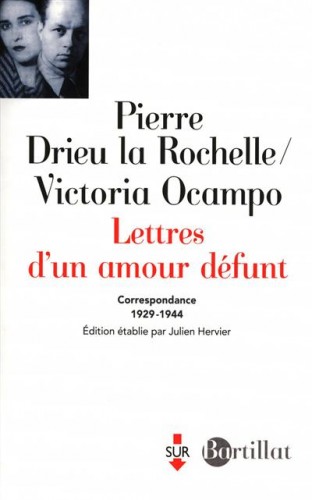 Ma chi era veramente Victoria Ocampo, al di là dell’eco di un nome che oggi, escluso qualche specialista, evoca pallide frequentazioni letterarie fra le due sponde dell’Oceano Atlantico, il nome di una rivista, Sur, e di un collaboratore d’eccezione, Borges?
Ma chi era veramente Victoria Ocampo, al di là dell’eco di un nome che oggi, escluso qualche specialista, evoca pallide frequentazioni letterarie fra le due sponde dell’Oceano Atlantico, il nome di una rivista, Sur, e di un collaboratore d’eccezione, Borges?
 La distanza, le differenze di opinioni politiche, la stanchezza che si insinua in ogni legame sentimentale, allenteranno nel tempo i rapporti, senza mai però reciderli. Negli anni ’30, un ciclo di conferenze in Argentina organizzato dalla Ocampo sarà per Drieu l’occasione per mettere a fuoco ideologie e scelte di campo: «È stato lì che ho capito che la vita del mondo occidentale stava uscendo dal suo torpore e che si apprestava ad essere lacerata dal dilemma fascismo-comunismo. Da quel momento, ho camminato rapidamente verso la caduta in un destino politico». La summa di tutto questo sarà, nel 1943, L’uomo a cavallo, storia di un dittatore boliviano che sogna l’unità del continente latino-americano e la riconciliazione delle classi sociali. Camilla, l’eroina del romanzo, è in realtà Victoria Ocampo, e naturalmente il loro è un amore destinato al fallimento. «Sarebbe ora che tu capissi che le donne sono anche esseri umani» gli aveva rimproverato un giorno... Perché Ocampo sapeva che «nella sua maniera di amare la Francia riconosco il suo modo di amare le donne che gli ho spesso rimproverato e che era poi così irritante, ma non meschino. Se Drieu è per una politica che non ci piace, non lo è per ragioni inconfessabili, basse o interessate. Un giorno gli dissi: Tu sei Pietro, e su questa pietra non costruirò la mia chiesa. Ma la mia tenerezza gli resta fedele, incurabilmente fedele».
La distanza, le differenze di opinioni politiche, la stanchezza che si insinua in ogni legame sentimentale, allenteranno nel tempo i rapporti, senza mai però reciderli. Negli anni ’30, un ciclo di conferenze in Argentina organizzato dalla Ocampo sarà per Drieu l’occasione per mettere a fuoco ideologie e scelte di campo: «È stato lì che ho capito che la vita del mondo occidentale stava uscendo dal suo torpore e che si apprestava ad essere lacerata dal dilemma fascismo-comunismo. Da quel momento, ho camminato rapidamente verso la caduta in un destino politico». La summa di tutto questo sarà, nel 1943, L’uomo a cavallo, storia di un dittatore boliviano che sogna l’unità del continente latino-americano e la riconciliazione delle classi sociali. Camilla, l’eroina del romanzo, è in realtà Victoria Ocampo, e naturalmente il loro è un amore destinato al fallimento. «Sarebbe ora che tu capissi che le donne sono anche esseri umani» gli aveva rimproverato un giorno... Perché Ocampo sapeva che «nella sua maniera di amare la Francia riconosco il suo modo di amare le donne che gli ho spesso rimproverato e che era poi così irritante, ma non meschino. Se Drieu è per una politica che non ci piace, non lo è per ragioni inconfessabili, basse o interessate. Un giorno gli dissi: Tu sei Pietro, e su questa pietra non costruirò la mia chiesa. Ma la mia tenerezza gli resta fedele, incurabilmente fedele». An Jean Raspails berühmt-berüchtigten Roman
An Jean Raspails berühmt-berüchtigten Roman  Dabei gilt es auch, den gigantischen Verrat zu sehen, der zur Zeit von den Eliten der westlichen Welt an ihren Völkern begangen wird. Raspails sardonische Karikatur der landauf landab herrschenden linksliberalen Psychose, die tagtäglich neue
Dabei gilt es auch, den gigantischen Verrat zu sehen, der zur Zeit von den Eliten der westlichen Welt an ihren Völkern begangen wird. Raspails sardonische Karikatur der landauf landab herrschenden linksliberalen Psychose, die tagtäglich neue